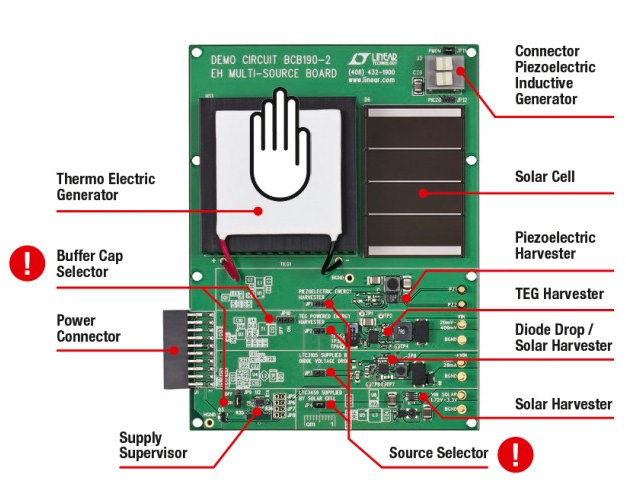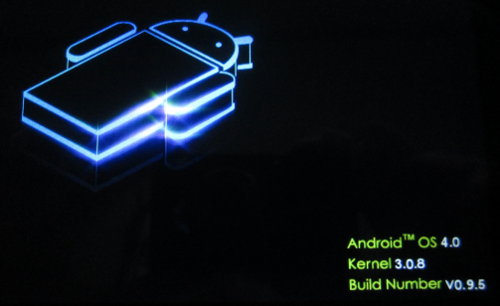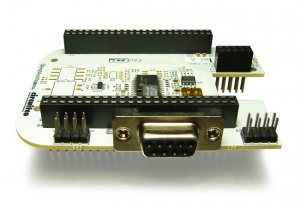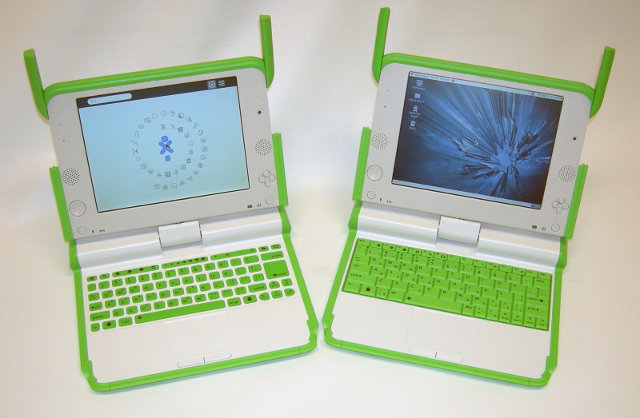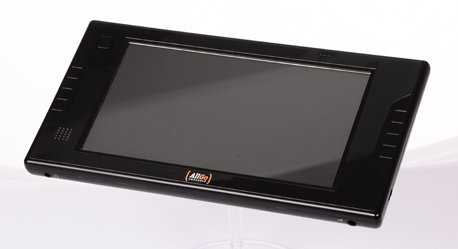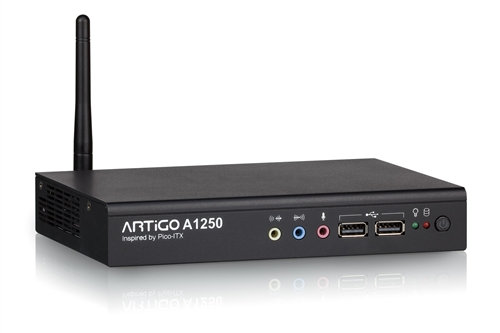If you’ve been following Linaro work, you may have read they develop big.LITTLE processing on TC2, a Test Chip based on 2 Cortex A15 cores and 3 Cortex A7 cores. Charbax is at ARM Techcon 2012 and he shot an interesting video showing 2 Versatile Express development boards based on TC2 demonstrate different big.LITTLE processing schedule strategies: The first scheduling strategy switches between Cortex A15 and Cortex A7 depending on the load required. The second scheduling strategy makes use of 5 cores at the same time and runs high load tasks on the Cortex A15 cores whereas simpler tasks are run on Cortex A7 core. This is only available on Android and Linux and the moment. TC2 is an actual silicon (not FPGA), and as they opened the casing of the development kit (Around 5:00 in the video), you’ll see a fan to cool down the SoC as it is […]
199 Euros “Energy Harvesting Solution To Go” Kit with Energy Micro Cortex M3 Starter Kit
If you’re interesting in battery less ultra low power applications, Energy Micro, Linear Technology and Würth Elektronik have announced an energy harvesting development platform early last month. The “Energy Harvesting Solution To Go” Kit is composed of an Energy Micro Giant Gecko (Cortex M3) Starter Kit and an energy harvesting board that is capable of getting enough solar, thermal, piezoelectric or electromagnetic energy to power the MCU board. The power connector shown above connects directly to the Giant Gecko Starter Kit board to provide power. Although there are 4 energy harvesters on the board, only one power source can be selected at a time via jumpers. Several power sources can be selected by using diodes. The board The energy harvesting board offers two integrated energy sources: A solar cell (32mm x 50mm) A thermo-generator (40mm x 40mm). And 2 other external energy sources can be added to the board via […]
WM8850-MID Tablet Firmware Files and Root Instructions
I’ve bought a noname tablet described as W8850-MID in the Android Settings that did not come rooted, and after several attempts trying to find how to root the tablet I had more or less given up, as tools such as UnlockRoot or OneClickRoot did not work with the device. After not using my tablet for 2 months, I started it again, but it just showed the Android animation forever, and failed to boot to the home screen. So I had to do something and finally managed to find firmware files for the device and root it. I’ll explain the whole process I went through in this post, but basically all you have to know is that if you have the same WM8850-MID tablet as I have (WM8850_MID7_PuZhi_W01_8223), it is fully compatible with Eken W70 and you can just install the latest W70 firmware (v1.10) from Eken support site that comes […]
The Beaglebord Community Launches The Beaglebone Cape Design Contest
The Beagleboard community has just announced the BeagleBone Cape Plug-in Board Design Contest. All you need to do (more easily said than done) is to design a Capefor the Beaglebone and submit the relevant materials during the contest period (November 1 – December 31, 2012) and if you’re one of the winner, you’ll receive cash prizes, a free devkit and you’ll become a Beagleboard community “God” as your Cape will be manufactured and sold through CircuitCo Electronics. To enter the competition, you’ll need to do the following by the 31st of December 2012: Come up with an original cape design and upload the Schematic layout and Bill of Materials (>$60) to an online sharing site (ex: Google Drive, Github) set for public view. Record a video describing your cape idea and upload it to YouTube. Click on the Submit Design Here button in http://beagleboard.org/CapeContest/ to submit your entry. On January 7, 2013, the list […]
OLPC XO-4 Touch Laptop Powered by Marvell ARMADA PXA2128
Last year, OLPC (One Laptop Per Child) announced their first laptop powered by ARM, with OLPC X-1.75 powered by Marvell ARMADA 610 single core processor (And sold over 100,000 since Q1 2012). The 2 new models – OLPC XO-4 and OLPC XO-4 Touch – will be upgraded to ARMADA PXA2128 triple core processor (2 ARMv7 Core + 1 Hybrid LPM (Low Power Mode) ARMv7 core), which the OLPC XO-4 Touch offering multitouch support. OLPC XO-4 laptop will look exactly like the OLPC 1.75 laptop pictured below. OLPC XO-4 will have the following specifications: SoC – Marvell PXA2128 (ARMv7 compatible) @ 1 GHz with Vivante GC2000 GPU System memory – 1GB or 2GB DDR3 RAM (Depending on configuration) Mass storage: 4 GB or 8GB NAND flash (eMMC) Internal microSD card slot for repair/replacement Externally accessible SD card slot; Display – 7.5” dual-mode TFT display with touchscreen (2 simultaneous touch max) Audio […]
$149 Hardkernel ODroid-X2 Development Board with Exynos 4412 @ 1.7 GHz and 2 GB RAM
You’ve probably heard about the ODROID-X development board announced in July by Hardkernel. They now have an updated version called ODroid-X2 with Samsung Exynos 4412 clocked at 1.7 GHz (vs 1.4 GHz) and 2 GB RAM (vs 1 GB RAM for the first version). They also boosted the Mali 400 clock speed from 400 MHz to 533 MHz. Apart from being a good mobile development platform, the 2 GB RAM could make the board a pretty good native ARM build machine under Ubuntu, as I’ve read 1 GB RAM is not always enough at link stage (e.g. for Debian packages, sorry I can’t find the link), unless you use swap which tremendously slows things down. The rest of the board seems identical and it just looks the same as the first version. Charbax shot a video of Hardkernel ODroid-X2 development board at ARM Techcon 2012: ODroid-X2 will cost $149 (ODroid-X […]
TI and AllGo Embedded Launch E-Tab Tablet Reference Design Powered by TI AM3354 Processor
Texas Instruments and Allgo Embedded jointly announced the availability of E-Tab, a tablet reference design based on Cortex A8 Sitara AM3354 processor that targets the healthcare, logistics, retail and education markets as well as hotels and restaurants. Here are the tablet reference designs specifications: Processor – TI’s AM3354 ARM Cortex-A8 microprocessor (up to 1 GHz) Operating System – Android ICS 4.0 System Memory – 512 MB DDR3 RAM Storage – 512 MB Nand Flash and 4GB Micro SD card Display – 7″ WVGA TFT LCD with 5-Touch Capacitive Touch panel Audio – Stereo Headphone, Internal MIC and Internal Mono Speaker Connectivity: WiFi 802.11 b/g/n + BT 2.1 Module Bluetooth 2.1 + EDR Ethernet 10/100Mbps (Optional) Camera – Internal USB Camera Module (Optional) USB Interfaces – USB High Speed Host Port and USB OTG (ADB and Debug purpose) Key/Button – Single Button for Back and Home screen, Reset Switch and Power […]
VIA ARTiGO A1250 Slim System Powered by Quad Core E-Series Processor
VIA Technologies announced the VIA ARTiGO A1250 slim system featuring a 1.0 GHz VIA QuadCore E-Series processor and VIA VX11H media system processor (MSP). The VIA ARTiGO A1250 is a low profile system targeted at home or office applications such as home server, home automation, hotel management, media streaming, digital signage, surveillance as well as medical and healthcare applications. Here are the key features of ARTIGO A1250: VIA QuadCore E-Series processor (U4650E) @ 1.0 GHz Up to 8GB of DDR3 1333 SDRAM SODIMM Supports one 2.5″ SATA HDD or Flash SSD installation Quiet, ultra slim profile design (3cm high) VIA VX11H media system processor with DirectX11 support 3D and HD video up to 1080p HDMI & VGA display ports with dual independent display support I/O: HDMI, VGA, 2x USB 3.0, 2x USB 2.0, GigaLAN, Audio-in/out/mic-in Average power consumption of 27W TDP Dimensions: 17.7cm x 12.5cm x 3.0cm I understand that inside […]



